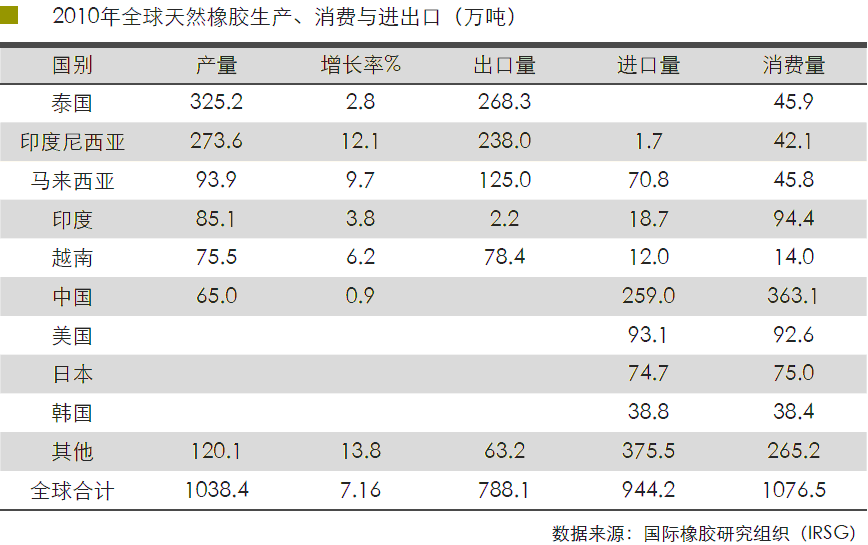Supply and demand
international market
natural rubber supply
The natural rubber tree is a tropical rainforest tree, and the planting area is basically distributed within 15 degrees of north-south latitude, mainly concentrated in Southeast Asia. Its planting area accounts for about 90% of the world's natural rubber planting area. The main producing countries are Thailand, Indonesia, Malaysia, India, Vietnam, China, Myanmar, Sri Lanka, etc., especially the former three countries. In 2010, the output of the former three countries accounted for 66.7% of the world's total output, and most of their natural rubber was used for export. At present, Thailand is the country with the largest output and export volume of natural rubber in the world. In 2010, the export volume reached 2.683 million tons, accounting for 82.5% of the output. However, in 2010, the growth rate of Thailand's output slowed down to 2.8%. The second and third rubber producing countries, Indonesia and Malaysia, saw rapid growth in production, which was mainly affected by the continuous record high prices of natural rubber in 2010, which boosted the enthusiasm of rubber farmers to cut rubber, as well as the expansion of planting in northeastern Malaysia and the increase of rubber forest production in the past few years.

Natural rubber demand
Natural rubber is mainly consumed in East Asia, South Asia, the United States and Western Europe, with the highest consumption in eastern and southern Asia. In 2010, the total consumption of China, India and Japan accounted for 49.5% of the global total. Among them, China's natural rubber consumption is the largest, reaching 3.631 million tons, accounting for 33.7% of the global total. India's consumption of natural rubber has grown rapidly in recent years, accounting for 8.8% of the global total in 2010, ranking second in the world. The United States dropped from the former largest consumer of natural rubber to the third, accounting for 8.6% of the global consumption share.
domestic market
Natural rubber supply
Natural rubber production areas in China include Hainan, Yunnan, Guangdong, Guangxi and Fujian, mainly in Hainan and Yunnan provinces. Generally, the tapping season in Hainan ranges from mid to late March to mid to late December, and that in Yunnan ranges from early March to early December. In 2010, China's natural rubber planting area ranked fourth in the world, and its annual output ranked sixth in the world. According to the statistics of China Natural Rubber Association, as of the end of 2010, the national natural rubber planting area was about 15.08 million mu, including 7.25 million mu in Hainan, 7.15 million mu in Yunnan, 630000 mu in Guangdong, and about 50000 mu in other regions. In 2010, 8.66 million mu of rubber plantations were opened nationwide, and the output of natural rubber reached 650000 tons. The national average output per unit area is 76.1 kg/mu, and the unit yield of rubber plantations in Yunnan Province is 101.5 kg/mu, ranking first in the country.
Natural rubber demand
Since 2002, China's natural rubber consumption has exceeded that of the United States, ranking first in the world. In 2010, China's natural rubber consumption reached 3.631 million tons, and the self-sufficiency rate was only about 18%. As China has gradually become the "factory of the world" in recent years, the demand for natural rubber continues to increase. It is expected that the proportion of imported natural rubber in the total consumption will further increase in the future.

Circulation characteristics
international market
Because the planting of natural rubber is restricted by factors such as geography and climate, the main production places of natural rubber are near the equator, while most of the major consumers of natural rubber cannot produce natural rubber or their production is limited. Therefore, from a global perspective, the circulation of natural rubber is characterized by flowing from the equator to all parts of the world, especially to North America, East Asia and Western Europe.
domestic market
The circulation characteristics of natural rubber in China are as follows: domestic natural rubber flows from south to north, and radiates outward from Shanghai, Qingdao and Tianjin, the main consumer areas. In addition, the Central Plains and Northeast China also account for a considerable proportion; The imported natural rubber mainly passes through Qingdao, Xiamen, Shanghai, Tianjin and other ports. In addition to being used by major import consumers, the rest of the imported natural rubber flows from east to west.
The natural rubber circulating in China's market is mainly smoke rubber sheet and particle rubber, of which smoke rubber sheet is mostly imported rubber, and particle rubber (standard rubber) includes domestic rubber and imported rubber. With the continuous improvement of the domestic tire meridianization rate, the import share of China's particle rubber has increased year by year in recent years.
Previously, the state implemented quota license management on imported natural rubber. The State Planning Commission issued quotas, then exchanged licenses from the Ministry of Foreign Trade and Economic Cooperation, and finally the customs tracked and managed the imported rubber to ensure that the quota rubber first met the production enterprises, prevent disrupting the domestic natural rubber market, and safeguard the interests of domestic rubber farmers. According to the WTO accession agreement, China began to cancel quota management in 2004, and adopted the natural rubber import registration system. Since then, the natural rubber import has entered a more market-oriented operation mode.


